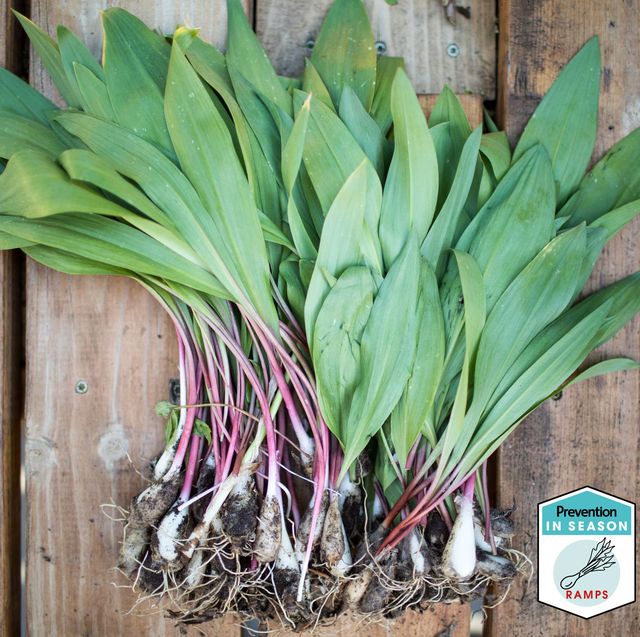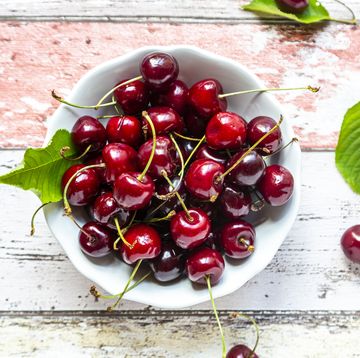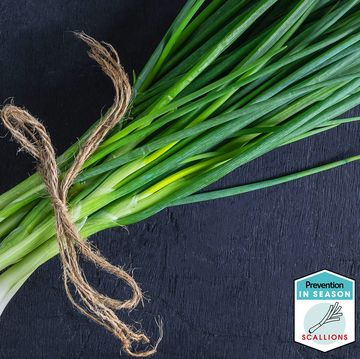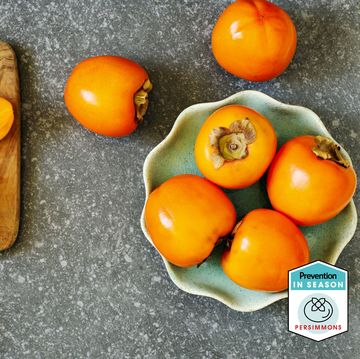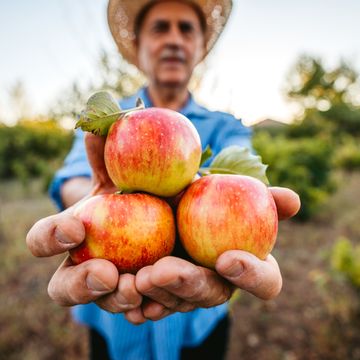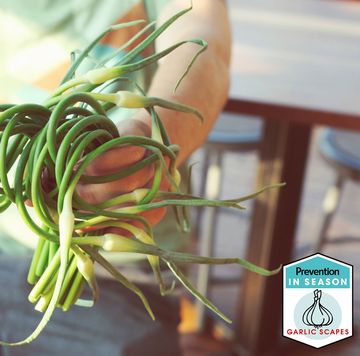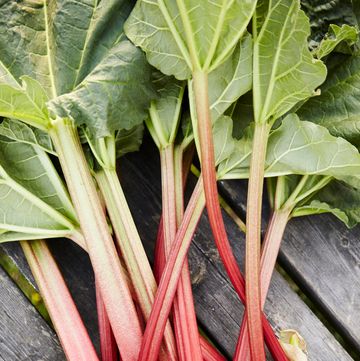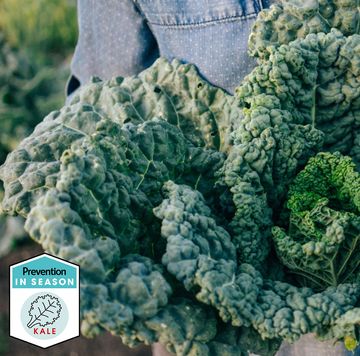You’re probably familiar with leeks, green onions, and other onion-like vegetables with leafy green tops. But the mysterious onions you may have seen for a fleeting moment at your local farmers’ market in the spring are ramps, and they’re foodie favorite vegetables that disappear from farm stands just as quickly as they pop up.
Sometimes called wild garlic or wild leeks, ramps are in the family of alliums and are a type of onion, explains Juliet Glass, director of communications at FRESHFARM, a non-profit that operates producer-only farmers’ markets in the Mid-Atlantic region.
The vegetable looks similar to others in the family. They’ll usually come with white bottoms and large, broad green leaves at the top, explains Lee Jones, a farmer behind The Chef’s Garden. They’ll also have a bulb at the bottom that varies in size with the roots typically still attached, adds Debra Moser, co-founder of Central Farm Markets in Washington D.C.
Ramps aren’t farmed traditionally like other early spring vegetables. Ramps are grown in muddy areas of the woods and foraged by farmers, Glass says. They’re found on the east side of hills, and grow in little patches, explains Jones. He notes that you shouldn’t harvest the entire hill at once so you allow the plants to continue growing.
Similar to onions, ramps tolerate the cold, but they only have their moment in the very early days of spring. They begin to sprout in Southern states that aren’t too warm and move their way up, Jones says. “It’s certainly one of the very first things that pop out in the woods,” he says.
Ramps nutrition
If you can snag ramps during their perfect season, you’ll score all the health benefits these vegetables provide. “If we can eat things in season and indigenously, there are some real health benefits to that,” Jones says.
Similar to other members of the allium family, ramps contain vitamin C, vitamin A, chromium, and selenium, explains Jennifer Agha-Khan, M.S., R.D., C.D.N., a contributor to Culina Health. She adds that they also contain organosulfur compounds that have been shown to have cancer-fighting properties.
Additionally, allium vegetables contain antioxidants that boost immune health and studies suggest they can help fight against chronic diseases like cancer and heart disease, notes Jessica Levinson M.S., R.D.N., C.D.N., culinary nutrition and communications dietitian based in New York. She adds they’re also a source of prebiotic fiber, which research says can be beneficial for gut health.
What do ramps taste like?
Ramps have a very distinct onion and garlic flavor, Glass says. “Their taste is really exquisite. It’s garlicky, oniony, and pungent,” Moser agrees.
Their smell is also very potent, so you’ll likely know the few weeks they’re at the farmers’ market because you’ll catch an instant whiff of intense onion and garlic, Glass adds. When using ramps in dishes, she suggests starting with just one or two because the flavor can be very intense, though delicious.
How to buy ramps
Because ramps are foraged in such a short time frame, it’s very rare you’ll find them at your local supermarket or out of season. If you’re lucky enough to find a bunch at your local farmers’ market during the early days of spring, Moser suggests avoiding wilted leaves and picking one with a firm, crisp stem and bulb.
How to store ramps
Like other leafy green produce, you’ll want to keep ramps dry until you’re ready to use them because moisture will make them spoil faster, Glass says. Wrap the ramps in a dishtowel and put them in a sealed container in the crisper, she suggests.
When you’re ready to use them, most ramps will be pretty well cleaned by the time you pick them up, Glass says. She adds you can use the entire plant (and you should because they’re expensive and fleeting, she notes). You’ll want to peel the outer skin if it appears too dirty, and be sure to give the leafy tops and bulb a rinse before cutting off the roots and using however you’d like for your recipe, Moser adds.
Why do foodies love ramps?
Ramps are a coveted vegetable in the early spring for a few reasons. Their peak season is incredibly short, typically beginning mid-March and lasting just about three weeks until early April, Glass says. Jones adds that they’re very important to many farmers because they’re a source of early income to get them through the last days of winter and early spring.
Plus, ramps tend to be one of the very first spring vegetables to be harvested, making an unofficial sign of spring and getting people excited for warmer weather and spring and summer produce, Glass says. She adds ramps are often harvested around the same time as asparagus and morels (a type of foraged wild mushroom), so they’ll typically be sold in bundles or paired together in dishes. “They mark a shift in the growing season,” Glass says.
How to use ramps?
Our experts agree that ramps are a little too pungent to enjoy raw, but they suggest these ways to use every part of the ramp during their peak season as often as you can.
- Store for stock. Glass says if there are parts of the ramp you don’t want to use in a recipe, store the scraps in a zip-top bag in your freezer and use for stock to infuse a pungent onion and garlic flavor.
- Scrambled in eggs. Jones says his go-to way to eat ramps is scrambled in eggs like any other vegetable for a delicious onion and garlic flavor while also getting in your greens.
- Blended. Ramps are a great substitute in an early spring pesto for earthy, garlicky flavor, Levinson says.
- Sauteéd with spring vegetables. As noted above, ramps are often sold alongside morels and asparagus because of their similar growing season. Glass says the trio makes a delicious sauté as a side dish.
- Make ramp butter. Moser likes to blend butter, salt, and ramps in a food processor and make ramp butter. She then wraps individual tablespoons in plastic and foil and freezes to use as needed in anything you’d normally use garlic and butter.
- Mixed into pasta. Levinson loves sauteéd ramps tossed into a weeknight pasta dish for an extra pop of flavor.
- Pickled. Savor the vegetable that only lasts a few weeks by giving them a quick pickle, Glass suggests. “You can enjoy them long past the foraging season and it tones down the funk,” she says. Levinson agrees, adding that pickled ramps make a great topper for avocado toast, salads, or tacos. Moser suggests adding a few the next time you put together a charcuterie board.

Arielle Weg is the associate editor at Prevention and loves to share her favorite wellness and nutrition obsessions. She previously managed content at The Vitamin Shoppe, and her work has also appeared in Women’s Health, Men’s Health, Cooking Light, MyRecipes, and more. You can usually find her taking an online workout class or making a mess in the kitchen, creating something delicious she found in her cookbook collection or saved on Instagram.
